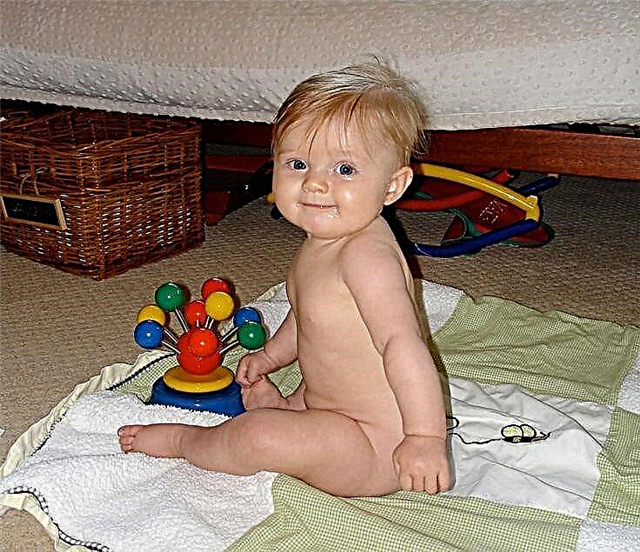
38 weeks pregnant - a real home stretch. A baby can be born at any time: both this week and a little later. Considering how long a journey has been, it is not surprising that various painful sensations accompany this period almost constantly.

How long is it
38 weeks pregnant is nine and a half obstetric months, each of which lasts 4 weeks. Since obstetricians always add two weeks to the real (embryonic) period, now the baby is developing 36 weeks. In the usual calendar sense, exactly 8 months and 2 weeks have passed.
A little more than two weeks remain until the date that the doctors marked as the expected date of birth of the baby, but this does not at all guarantee that the birth will take place on the day indicated by the doctor in the exchange card of the pregnant woman. The current 38th week is a very real time for the birth of a baby. The kid has matured, he is developed enough to live in this world. Therefore, most women already have bags with things for the maternity hospital collected and have long been in the most prominent place.

Physiological features of the week
Most pregnant women by 37-38 weeks feel constant fatigue. It becomes very difficult and difficult to carry the belly, because the uterus has already filled the entire abdominal cavity, and inside it is a baby, which, in turn, leaves no free space inside the female genital organ. The center of gravity changes, because of this, the load on the muscles of the back, on the lower back increases. A large belly creates a lot of inconvenience when performing habitual daily activities: it is impossible for a woman to bend down, quickly change her body position, walk or stand for a long time.
The uterus this week can strongly squeeze the diaphragm with its bottom, because of which the woman will be tormented by shortness of breath and an obsessive feeling that she cannot breathe in deeply. As the uterus descends, and in most women, by this week it is already located lower than before, due to the fact that the baby has taken a "prelaunch" position: resting his head against the exit from the small pelvis.

Hormonal prenatal changes make a woman sensitive and emotional. The fear of what awaits in the birth process, again, does not add calmness. For this week, a little weight loss is considered completely normal, and if this happens, then labor is not far off. Weight goes away along with excess fluid that previously accumulated under the influence of progesterone. The production of this hormone before childbirth decreases, and therefore the weight begins to decrease.

The placenta is still doing a good job with its functions, but it is already beginning to “grow old”, it is getting thinner, which also contributes to the loss of a couple of kilograms of weight by the mother. The volume of amniotic water also decreases.
Increasingly, a woman is tormented by training fights. The abdomen, even if it sank, becomes hard from time to time. The baby squeezes the nerve endings with the head, which can cause tingling of varying intensity in the perineum. And at this time, and in the next 38-39 weeks of gestation, the expectant mother may be plagued by rather pronounced pain in the abdomen.

Abdominal pain
The variety of pain in the abdomen is now surprising in its amount. However, not all of them are signs of the onset of labor and do not mean that it is time to go to the hospital. It is much easier for multiparous people to navigate the "signals" of the body, but for those who are expecting their first child, it is not easy, and each stretching and tingling sensation seems to them a "long-awaited start."
False contractions
Women who are going to give birth for the first time can begin to feel them first. In multiparous women, training contractions usually begin a little later, and sometimes just a few days before the upcoming birth. Such contractions help the uterine muscles prepare for the test that is coming very soon. If the first birth is coming, then this week training contractions are observed in about 95% of pregnant women.

False contractions are distinguished from real contractions primarily by the fact that they are not of a long-term nature and temporal patterns. They are felt as a pulling sensation, similar to those that a woman previously experienced during menstruation. The lower back slightly hurts, pulls the lower abdomen. The uterus “turns to stone”, and then, when it stops pulling, it becomes soft again.

If a woman lies down and takes a nap, or simply rests in a horizontal position, false contractions will pass without a trace. The same cannot be said about true contractions, which are considered a sure sign of the onset of labor.
Not all pregnant women experience unpleasant pain during training contractions. There are expectant mothers who only feel stretching in the lumbar region and ovaries.

Real fights
True contractions begin just before childbirth and are part of the birth process. The cervix is dilated, which is accompanied by contractions. Their beginning resembles training contractions, but the advice to lie down so that "everything goes away" will not work here. Even in a resting position, contractions will intensify, their frequency will increase, and the time between them will decrease. The painful sensations will also become more pronounced.
At first, a woman may notice that the tummy aches and hardens with localization of pain in the lower abdomen. Then the uterus turns to stone more often, and the pain becomes girdle, aches and hurts not only the lower abdomen, but also the lower back and back. Pulls the lower back more and more. "Stony" belly means that the uterus is toned, tense. This happens at the peak of the contraction, then the muscles relax, the woman feels relief.

Contractions usually last no more than 30 seconds at first, repeated every 10-15 minutes. In this stage, a woman who is going to give birth for the first time can stay up to 8 hours or even more. The opening of the cervix will be only 3 centimeters.
The second stage is the duration of the contractions for a minute or more with repetition every 4-5 minutes or more. This period lasts less than the first, and therefore it is desirable for a woman to already be in the hospital under the supervision of doctors.
The third stage, preceding attempts, is the shortest. The contractions are repeated after about half a minute and each last up to 90 seconds.

The question of when to go to the hospital is not easy to answer. A primiparous woman may not be in a hurry, because her first stage of true contractions is longer than that of expectant mothers who have already given birth.
If childbirth is repeated, then you need to go to the hospital immediately when regular contractions appear, unlike training ones. It is usually believed that, regardless of the number of previous births, you need to arrive at the obstetric facility with contractions every 7-10 minutes.

Digestion
Since the physiological feature of this week is such that the internal organs are pressed against by a large and heavy uterus, in the later stages, abdominal pains sometimes have nothing to do with childbirth, but are exclusively associated with impaired peristalsis, intestinal disorders, and impaired bile outflow. These pains appear as cramps or tingling sensations in the lower abdomen, the abdomen "twists", while it can also be hard. Changes in body position can cause increased pain, while the stomach often boils. Loose stools or constipation, nausea, vomiting are not excluded.
Abdominal pain, which occurs at 38 weeks due to disruption of the digestive system, is accompanied by sensations of severe swelling of the intestines, distention. Most often, the pain is observed in the iliac region, after a bowel movement it can intensify. It is this that suspicious and impressionable mothers-to-be are often perceived as a harbinger of childbirth.

A small percentage of women experience no pain at 38 weeks at all. They usually have high compensatory abilities, thanks to which the body, even in extreme conditions, continues to work without interruption.
Allocations
Discharge by the end of pregnancy always changes. To help a woman navigate in time in a situation are called "pads-daily". They will not allow you to miss the moment when it is time to go to the hospital or an urgent doctor's consultation is needed. What can be said about the discharge at this time:
- Norm... The fact that a woman is fine is indicated by light, white or yellowish discharge, which has a weak sour smell or is devoid of odors at all. The amount of discharge depends on the hormonal background, but in general it is assessed as moderate.
- Mucous discharge. If a woman drew attention to the fact that the discharge became mucous, this may indicate the passage of the plug, which tightly closed the cervical canal throughout the pregnancy from the penetration of foreign bodies, bacteria, viruses into the uterus. The plug can come off as a clot of mucus, transparent with streaks of blood. Sometimes the plug comes off gradually. In this case, mucous discharge lasts for several days, brownish or pink streaks of blood may be visible in them.
Cork discharge is a sign of the imminent onset of labor. A woman should, without unnecessary panic, calmly pack her things and go to the obstetric facility. After the beginning of the cork discharge, a hot bath, sex, douching are contraindicated.

- Watery discharge. Such discharge may indicate the discharge of amniotic fluid. As in the case of the plug, the amniotic fluid may come out entirely or leak in parts. Complete outpouring usually raises no questions. If the water has departed, it's time to go to the hospital. If a woman notices that the discharge has become more, and they are watery, then we can talk about leaking. The woman's actions in this case, too, should be aimed at prompt hospitalization. Leakage is a danger to your baby. Sometimes this watery discharge has a greenish tint. If such discharge is noticed, it is necessary to urgently go to the hospital, because it is possible that meconium is present in the leaking waters - the original feces from the intestines of the fetus.
He usually comes out after the baby is born. But in the case when there is a Rh-conflict, the child experiences hypoxia, with entanglement, placental insufficiency, defecation may be premature: right in the womb. This situation is the basis for urgent delivery.

- Brown and pink discharge... Discharge of brown color, as well as pink, if they are not associated with mucous secretions and are not a sign of a cork discharge, may indicate blood impurities. There can be many reasons: from problems with the placenta to pathological changes in the cervix. It is imperative to inform your doctor about bloody discharge. Although the birth is already very close, there should not be blood in them.
- Strong yellow or greenish discharge... Such discharge may indicate that the woman has a genital tract infection. An inflammatory and suppurative inflammatory process can be caused by bacteria and fungi.
Usually, a change in the nature of the discharge occurs simultaneously with the appearance of unpleasant sensations in the area of the external genital organs - itching and burning appear. The discharge has an unpleasant odor and often foams. A doctor's consultation is mandatory, because before childbirth it is necessary to sanitize the genital tract, otherwise the child risks becoming infected.

Discharge after a doctor's examination
If, at 38 weeks of pregnancy, after a doctor's examination, a woman has brown discharge, then this is considered the norm. You should not panic and worry. The mucous membranes of the genital tract under the influence of hormones become looser and more vulnerable, and therefore examination of the cervix may well provoke the appearance of bloody discharge. They usually go away within a few hours after returning from the consultation.
If, during the examination of the uterine ganglion, the doctor provoked the discharge of the remnants of the mucous plug, which will be manifested by secretions after the examination, then labor will begin in the near future. Again, you don't need to panic, you just need to be fully armed.

Reviews of expectant mothers
At this time, the sensations of women are quite similar. Many people note fatigue and heaviness in the abdomen, frequent urination. Control over secretions and painful sensations is carried out by all pregnant women, because the understanding that the child can "ask" outside at any moment does not disappear for a minute.

Many people this week are starting to complain that labor takes so long to come. Expectant mothers want to give birth sooner and again feel light and mobile.
For what happens to mom and baby at 38 weeks pregnant, see the next video.



